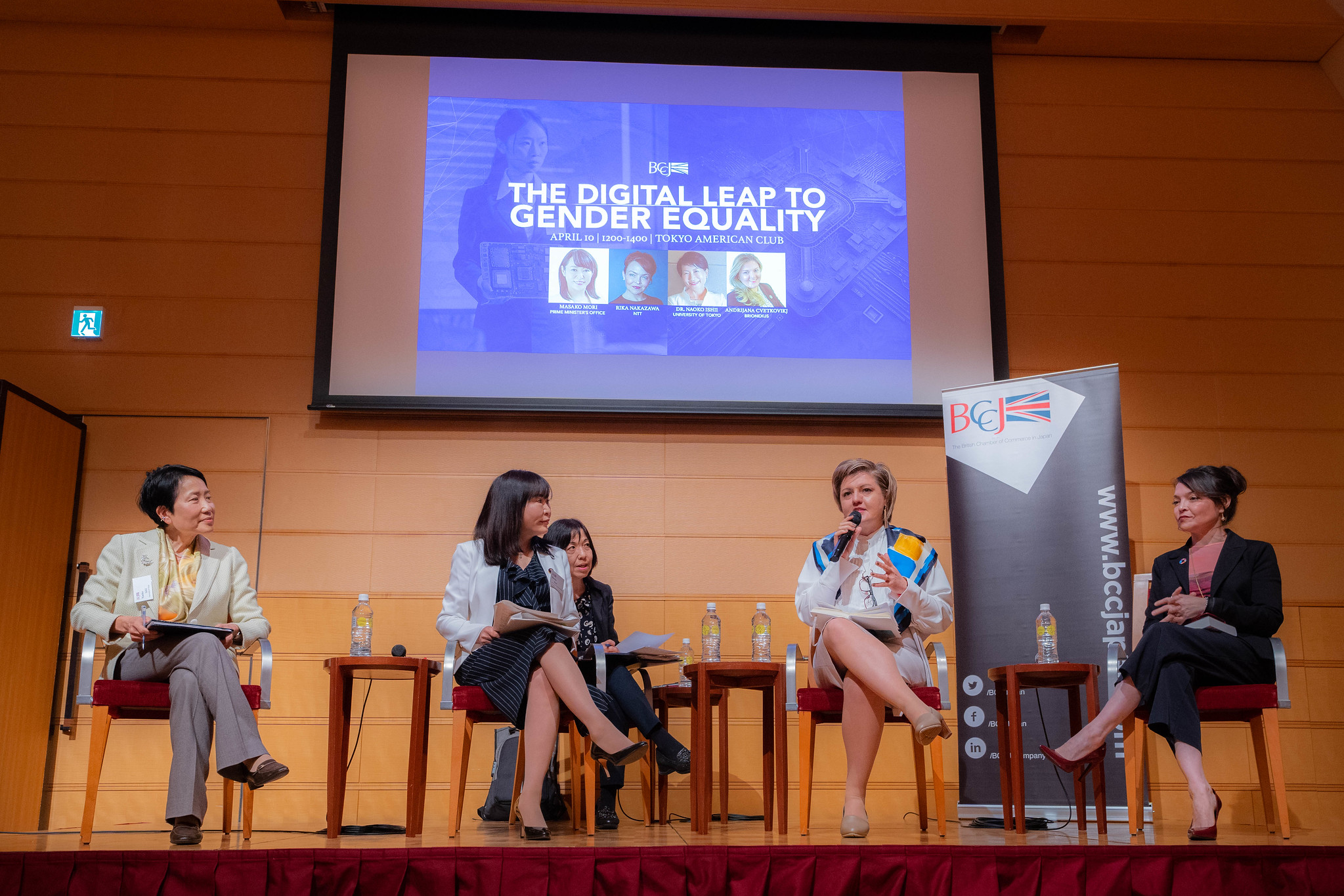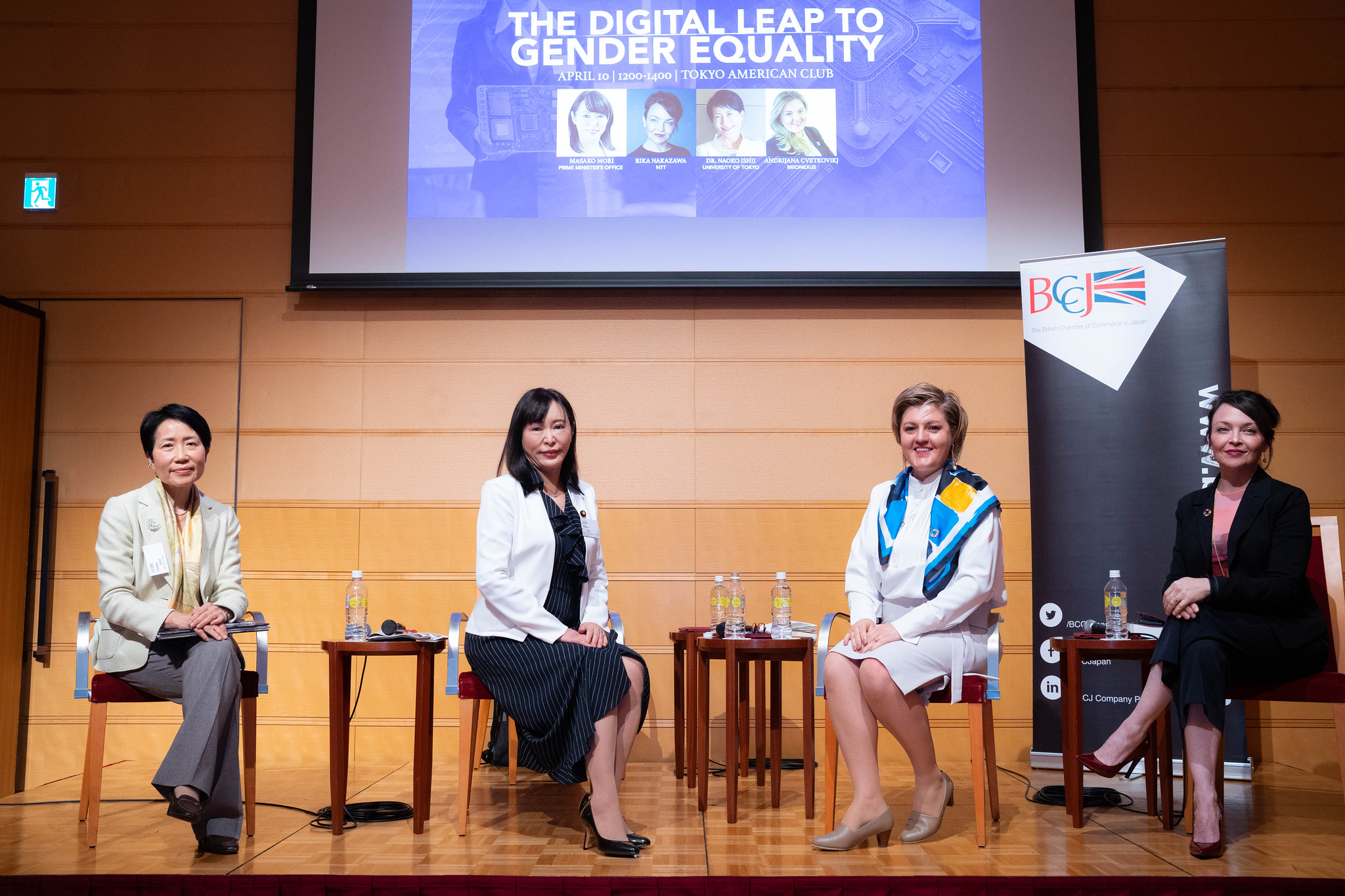Member? Please login
Digital leap to gender equality

Written by Sterling Content
May 12, 2023
Diversity & Inclusion, Past Event Round Ups
With greater utilisation of technology offering opportunities to advance gender equality, the public and private sectors are keen to maximise the potential of digital for women’s empowerment in Japan.
The push to digitise the country, announced by the Japanese government in September 2020, could result in the creation of new jobs, as well as boost productivity and contribute to targets on sustainability and diversity, equity and inclusion. But it also presents challenges including the possibility of women being left behind due to gender disparities in digital skills and access to technology.
The need for a digital revolution is becoming increasingly clear, according to recent studies. The UN Women’s Gender Snapshot 2022, for example, shows lack of digital representation for women has cost low- and middle-income countries $1 trillion over the past decade.
At a special event to conclude a celebration of International Women’s Month, an expert panel from government, academia and business presented their thoughts on the “digital leap to gender equality,” to members of the British Chamber of Commerce in Japan in April. They were led by Andrijana Cvetkovikj, president and CEO of BrioNexus Co., Ltd. and an executive committee member of the British Chamber of Commerce in Japan,
Cvetkovikj outlined the need to put an end to gender inequality, a blight on society that results in an estimated $160 trillion loss in wealth globally, according to the World Bank. She noted that Japan can seize opportunities provided by digital growth, including “the advancement of women in decision-making roles in the digital sector,” but cautioned that only 45% of Japan’s female population report having digital skills compared to 65% of men. This means there is a need for training and re-skilling of women, she said.

Government intentions
Keynote speaker Masako Mori, special advisor to Prime Minister Fumio Kishida on women’s empowerment, gave a keynote speech outlining the Japanese government’s intention “to realize a new form of capitalism with women’s empowerment at its core,” as demonstrated by her role, a first for Japan.
In 2022, Kishida became the first prime minister in Japan’s history to deliver a message to mark International Women’s Day on March 8, and the subsequent Japan–US joint statement on competitiveness featured women’s empowerment for the first time. Furthermore, Kishida will promote discussions incorporating a gender perspective at the G7 Summit, to be held over May 19–21 in Hiroshima, and at each ministerial meeting, she said.
Mori noted Japanese government plans announced in 2023 to promote “unprecedented measures” to address the country’s declining birth rate and outdated work practices while providing financial support for childrearing and childbirth. On April 1, Kishida also established an administration for children and families.
These actions are just part of the solution to Japan’s lowly performance in the World Economic Forum’s Global Gender Gap Index, announced in July 2022. The country ranked 116 out of 146 countries, a position that Mori said is “shameful” as it shows “how far Japan is behind the world.”
Still, she pointed out that Japan performed very well in some areas, namely health and survival (0.97) and educational attainment (1.0) on a scale of 0–1, with 0 being the lowest and 1 being the highest. Japan fell down in economic participation and opportunity (0.56) and political empowerment (0.1), but Mori noted that the index takes account of only women members of the House of Representatives (9.9% as of April 2021). Meanwhile, the percentage of female representation in the House of Councillors has been increasing in recent years to reach 23% as of April 2021.
Mori admitted, though, that “other countries are working faster” than Japan to address their gender gap, so “further efforts are needed” nationwide.
Making progress
Mori outlined some of the obstacles that the Japanese government has been facing in the empowerment of women, as well as achievements to date.
In the business world, one obstacle was the outdated mindset of leaders, which prompted the Japanese government to invite members of Keidanren (Japan Business Federation) to appoint more women to senior corporate positions.
Corporations have also been encouraged to be more transparent about how they work to empower women, such as the ratio of women in management positions or the ratio of men who take childcare leave, Mori explained, noting that 35% of businesses in Japan now voluntarily disclose this information. Kishida also strengthened gender gap disclosure rules in 2022, which will require companies to disclose how they pay their male and female staff.
Other obstacles that the Japanese government has been tackling centre around childcare leave and childcare provision, which are “barriers to women’s empowerment,” said Mori. The government increased parental leave allowances from 50% to 67% in 2014, putting Japan’s benefits on par with Sweden. And Kishida announced in March 2023 that that ratio would be increased to 100%.
Japanese government efforts have also resulted in a reduction in the number of children on waiting lists for nursery school care, down from 26,000 to 3,000 over the past six years, she said. Funding was also provided for 900,000 children to attend after-school childcare facilities, far exceeding the target of 22,000.
In disaster planning, Mori said “the most important lesson” from the Great East Japan Earthquake and subsequent recovery is that “gender must be taken into consideration” both before and after disasters occur. If women are involved in the four phases of comprehensive emergency management—mitigation, preparedness, response and recovery—they can “play an active role in decision-making, consensus-building and policy development,” she said.
Women in STEM
Moderator Cvetkovikj asked panellists Dr Naoko Ishii, professor and executive vice president at The University of Tokyo, and Rika Nakazawa, group vice president of connected industry and sustainability for the Americas at NTT, how Japan could increase the representation of women in science, technology, engineering and mathematics (STEM), a field where the country also falls behind the OECD average.
Ishii suggested educational institutes should aim to rid Japan on the long-held stereotype that women are unsuitable for, or not good at, STEM, which has resulted in few domestic prospects for women in the sector.
“There is also, fundamentally, a social norm that people good at STEM are smart—and smart women are not appreciated in Japanese society. We need to work harder to tackle this stigma,” she said.
Nakazawa said the STEM sector offers a vast range of opportunities, including many pathways into the world of technology alone that allow women to play different roles in organisations.

“As a woman who has spent her entire career in tech, it’s a mistake to think that you have to be an engineer or in IT to pursue a career in it,” she said, adding that the pandemic has spurred on greater digitalisation in many fields that have created new roles and career paths. Moreover, with the growing need for creativity, innovation and collaboration to tackle social problems, alternatives to STEM are being penned, such as STEAM (to incorporate arts) and SHTEAM (to incorporate arts and humanities).
Cvetkovikj suggested that women currently working in these areas be spotlighted as role models for young people and included in decision-making bodies in government, universities and the public sector to help drive change.
Securing digital talent
In posing questions on how women can improve Japan’s digital competitiveness, Cvetkovikj pointed to a survey of 2,000–3,000 firms which showed Japanese companies were most concerned about digital talent, at 70%, compared to China (56%), Germany (50%) and the United States (27%). Moreover, Japan ranked 29th among 63 economies in global digital competitiveness in 2022, mostly due to a shortage of digital workers.
One answer could be “united stakeholder collaboration with policy makers and communities” to ensure gender-balanced governance in organisations, according to Nakazawa.
“Prior to the pandemic, the usual profile of boards were former CFOs and CEOs. When the pandemic hit, there was a need for someone from HR to be in the room due to the mobilisation of talent, and we saw the rise of chief HR officers and chief people managers,” she said.
Post-pandemic, corporations should start working with universities and beyond to fill digital talent gaps by celebrating leaders and increasing their visibility, she added, noting “if you don’t see it, you can’t be it.” Women in STEM need support as they face a glass ceiling and bamboo ceiling—now it’s a silicon ceiling as so much of the tech sector is dominated by men, she said.
Universities, meanwhile, may be “in the best position” to break the unconscious bias embedded in society that results in Japan’s IT talent shortage, which is estimated to total 1 million staff, according to Ishii. The question is how the academic sector can foster talent for “real business needs,” she said.
Mori noted that women who were trained or re-skilled to work in digital industries following damage to the economy caused by the Great East Japan Earthquake and the COVID-19 pandemic have played a key role in business development and entrepreneurship in the Tohoku region.
Looking at the growth of artificial intelligence (AI), Nakazawa said it is possible the technology can bring more gender parity into the workforce but cautioned that AI needs to be designed and built by a diverse team with a wide range of opinions to ensure it is not unintentionally embedded with unconscious bias, thereby perpetuating the gender gap.








